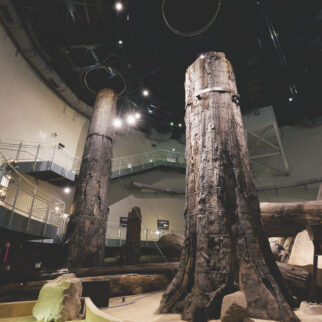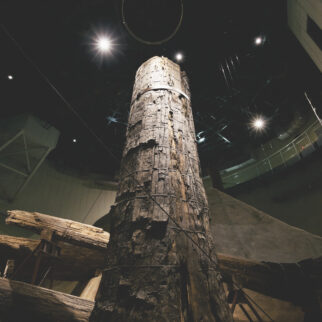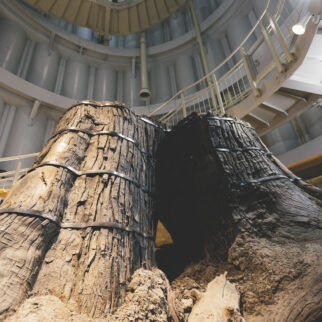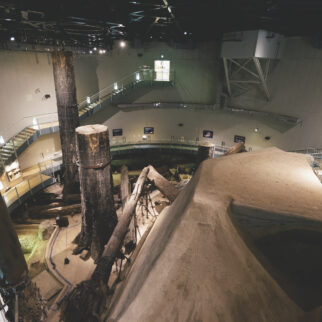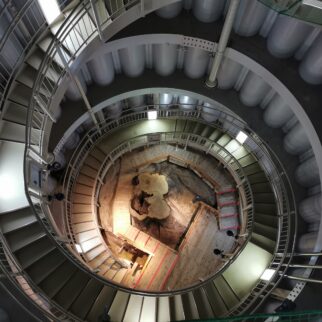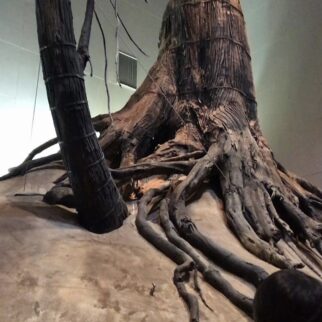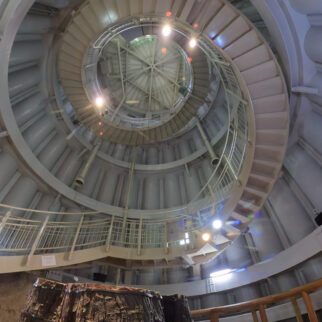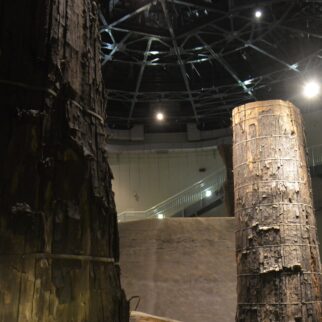 Ancient Jomon Forest reborn
Ancient Jomon Forest reborn
in modern times


A mysterious forest towering underground
Sanbe Azukihara Buried Forest

A Jomon period forest with huge trees. The Sanbe Azukihara Buried Forest is a valuable site that gives us a view of an ancient Jomon Forest. This forest lays buried under the ground for about 4000 years.
The excavated forest comprises mainly cedar trees, many of which are massive, with trunks around 2 meters thick. In the underground exhibition room, where the site has been partly excavated, several giant trees stand, still rooted to the ground just as they were when the forest still lived. Even broken off as they are, the tall, straight trunks of these Japanese cedars exceed 10 meters in height, and it is estimated that the height of these trees when they were alive was more than 40 meters. If you look up at the trees, you can imagine the scenery of the forest as it would have been seen by the Jomon people. Untouched by human development, a great forest grew up here over hundreds to thousands of years.
The eruption of Sanbe Volcano played a role in preserving this forest to the present. Although the trees were hit by debris and pyroclastic flows generated by volcanic activity, thanks to a combination of topographical coincidences, they were not knocked down or burnt up, but were buried deep underground and miraculously preserved to the present day.


- 1Discovery of the Jomon Forest
- The Sanbe Azukihara Buried Forest was discovered during an archaeological excavation in 1998. Even before that, the existence of buried trees was known locally. There were two standing petrified trees with their tops exposed on the riverbed of the Azukihara River, which runs through the area, and other standing trees would sometimes appear when riverbanks were carved away by floods.
In 1983, two standing petrified trees were discovered during construction work for rice field consolidation (land development). Inspired by a photo taken at that time, Mr. Seiji Matsui, who had been studying the Sanbe Volcano, conducted a survey and pointed out the possible existence of a buried forest of standing trees. Based on the results of his survey, Shimane Prefecture conducted an excavation survey leading to the discovery of the buried forest. - 2Types of trees
- During the excavation survey of the Sanbe Azukihara Buried Forest, about 30 standing trees and more than 150 large and small pieces of fallen trees were found. Japanese cedar accounts for 73% of the standing trees and 54% of the fallen trees, and makes up an overwhelming majority of the large trees exceeding 1 meter in diameter. Other species such as types of oak and horse-chestnut are scattered among the cedars, and it can be inferred that about 4,000 years ago, at the foot of Mt. Sanbe, there was once a forest made up mainly of huge cedars with a smattering of broad-leaved trees.
- 3A topographical coincidence
- The Sanbe Azukihara Buried Forest was buried gradually through several phenomena. First, a large-scale avalanche of debris occurred due to the collapse of the volcano, and flowed down the valley next to Azukihara. When this happened, the point at which the Azukihara valley and the adjacent valley merged became filled with dirt and sand, some of which climbed up the Azukihara valley and reached the location of the buried forest. One reason why the trees were buried standing upright was that the momentum of the avalanche was weakened by the backflow. The Azukihara valley was transformed into a landslide dam by the debris, and when water had begun to accumulate, a pyroclastic flow hit the area directly. The hot pyroclastic flow is thought to have been quenched by the water, leaving the trees with only slight charring on their bark. After that, fine volcanic ash carried by the river was deposited in a thick layer on the landslide dam, and the standing trees were buried at a depth of more than 10 meters.
Sediment deposited in this way is generally eroded and lost in a relatively short period of time, but the bedrock of the Chigodaki Falls downstream helped to prevent erosion, and thus the tree trunks remained buried for such a long period of time.

- Sanbe Azukihara Buried Forest Park
(Sanbe Jomon no Mori Museum) -
- 58-2 Tane, Sanbe-cho, Oda City, Shimane, 694-0003
- TEL: 0854-86-9500







